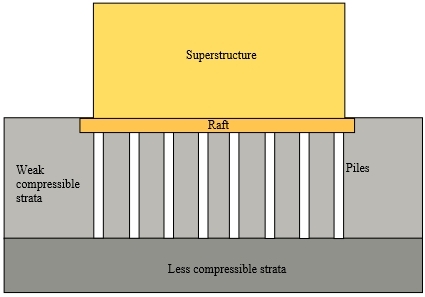Piled raft foundation
Foundations provide support for structures, transferring their load to layers of soil or rock that have sufficient bearing capacity and suitable settlement characteristics.
Very broadly, foundations can be categorised as shallow foundations or deep foundations:
- Shallow foundations are typically used where the loads imposed by a structure are low relative to the bearing capacity of the surface soils.
- Deep foundations are necessary where the bearing capacity of the surface soils is not adequate to support the loads imposed by a structure and so those loads need to be transferred to deeper layers with higher bearing capacity.
In their normal form, raft foundations (sometimes referred to as mat foundations) are shallow foundations formed by a reinforced concrete slab of uniform thickness (typically 150-300 mm) covering a wide area, often the entire footprint of a building. This 'raft' spreads the load imposed by a number of columns or walls over the area of foundation, and can be considered to ‘float’ on the ground as a raft floats on water.
However, where a conventional raft foundation does not provide adequate support, it can be enhanced by the addition of piles, creating what is known as a piled raft foundation.
Piles are deep foundations. They are formed by long, slender, columnar elements typically made from steel or reinforced concrete. A foundation is described as 'piled' when its depth is more than three times its breadth (Atkinson, 2007). Pile foundations can help transfer loads through weak, compressible strata or water onto stronger, more compact, less compressible and stiffer soil or rock at depth.
The addition of piles to a raft increases the effective size of a foundation and can help resist horizontal loads. This can improve the performance of the foundation in reducing the amount of settlement and differential settlement, as well as improving the ultimate load capacity.
Piled raft foundations are typically used for large structures, and in situations where soil is not suitable to prevent excessive settlement. They are an increasingly popular choice for high-rise buildings.
During the design process, the optimum number and position of piles, as well as their diameter, reinforcement and length, is determined to ensure the stability of the structure while providing an economical solution, with the raft and piles acting together to ensure the required settlement is not exceeded. Typically, the piles provide most of the stiffness while the raft provides additional capacity at the ultimate loading.
If there are one or more ineffective piles, the raft can allow some degree of load redistribution to other piles, reducing the influence of the pile’s weakness on the overall performance of the foundation.
In an Unconnected Piled Raft Foundation (UCPRF), the piles are not directly connected to the raft, but are separated from it be a structural fill 'cushion' (such as a compacted a sand-gravel mixture or compacted soil) which redistributes load between the raft and piles. This can be a more efficient, and so economic solution.
[edit] Related articles on Designing Buildings
- Driven piles.
- Foundations.
- Geothermal pile foundations.
- Micropiles.
- Pad foundation.
- Pile cap.
- Pile foundations.
- Raft foundation.
- Screw pile foundations.
- Secant pile wall.
- Types of raft foundation.
- Types of pile foundation.
[edit] External references
- Numerical analysis of unconnected piled raft with cushion. Alaa Ata, Essam Badrawi, Marwa Nabil. https://doi.org/10.1016/j.asej.2014.11.002
Featured articles and news
Professional practical experience for Architects in training
The long process to transform the nature of education and professional practical experience in the Architecture profession following recent reports.
A people-first approach to retrofit
Moving away from the destructive paradigm of fabric-first.
International Electrician Day, 10 June 2025
Celebrating the role of electrical engineers from André-Marie Amperè, today and for the future.
New guide for clients launched at Houses of Parliament
'There has never been a more important time for clients to step up and ...ask the right questions'
The impact of recycled slate tiles
Innovation across the decades.
EPC changes for existing buildings
Changes and their context as the new RdSAP methodology comes into use from 15 June.
Skills England publishes Sector skills needs assessments
Priority areas relating to the built environment highlighted and described in brief.
BSRIA HVAC Market Watch - May 2025 Edition
Heat Pump Market Outlook: Policy, Performance & Refrigerant Trends for 2025–2028.
Committing to EDI in construction with CIOB
Built Environment professional bodies deepen commitment to EDI with two new signatories: CIAT and CICES.
Government Grenfell progress report at a glance
Line by line recomendation overview, with links to more details.
An engaging and lively review of his professional life.
Sustainable heating for listed buildings
A problem that needs to be approached intelligently.
50th Golden anniversary ECA Edmundson apprentice award
Deadline for entries has been extended to Friday 27 June, so don't miss out!
CIAT at the London Festival of Architecture
Designing for Everyone: Breaking Barriers in Inclusive Architecture.
Mixed reactions to apprenticeship and skills reform 2025
A 'welcome shift' for some and a 'backwards step' for others.






















